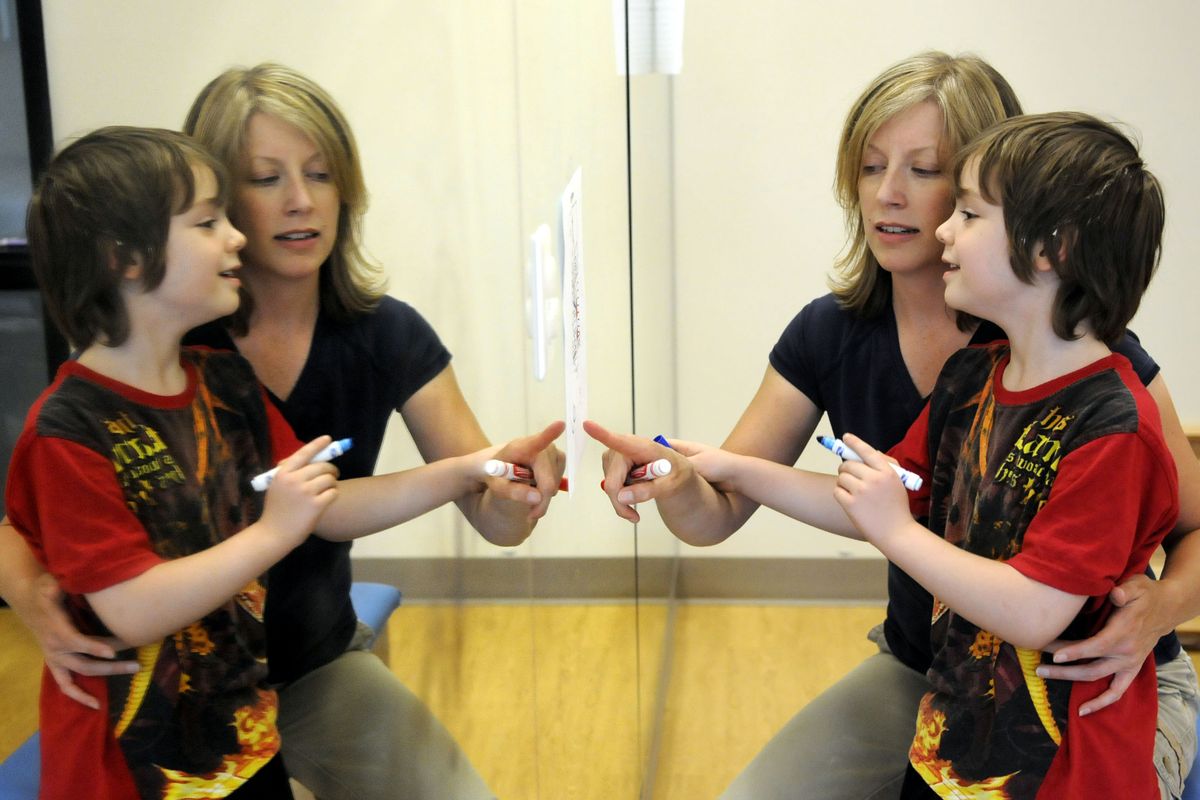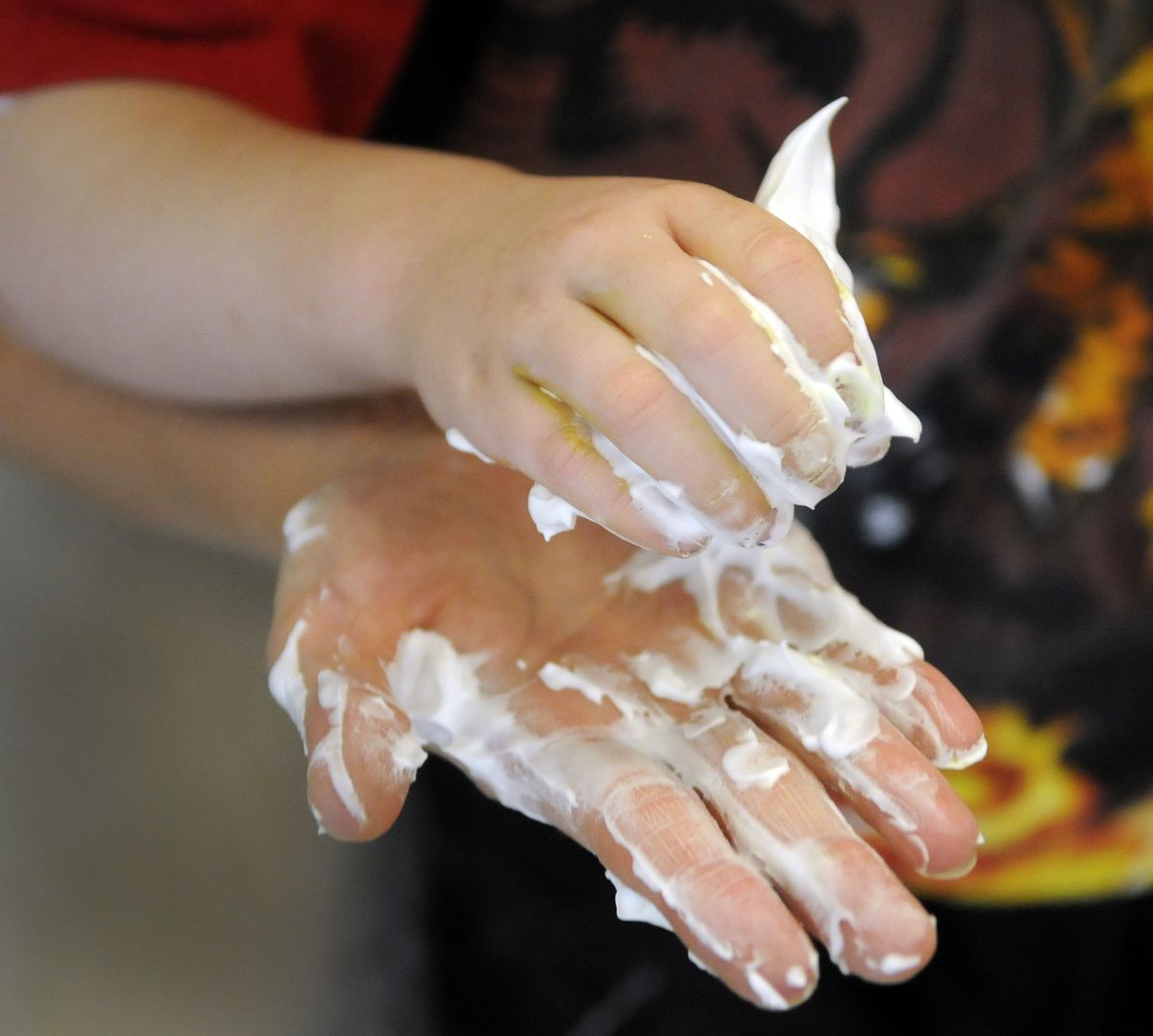For SPD sufferers, distractibility is a daily struggle
Joanne Fister, an occupational therapist, guides Jacob Carruth through a sensory exercise. (Dan Pelle)
Imagine a world where the tags in your clothes are so itchy, you have to cut them all out. And Aunt Mary’s perfume makes you feel carsick, so you hesitate each time she reaches out for a hug. That pencil-tapping from the guy three desks down? May as well be a jackhammer outside your window.
Or maybe you’re on the other side of the fence: You wish you could ride roller coasters every day, and the only way you like to listen to music is when it’s so loud, the floor vibrates. That food that’s turned bad in your fridge? You seem to be the only one who can’t smell it.
It’s called Sensory Processing Disorder. Named in the 1960s by California psychologist Dr. Jean Ayres, Sensory Processing Disorder, or SPD, affects the central nervous system.
Ayres likened it to a neurological “traffic jam” when the brain processes sights, sounds, smells, touch and things such as the perception of gravity, pressure and movement. In 1979, Ayers estimated that between 5 percent and 10 percent of children struggled with enough sensory integration issues to warrant intervention. Today, experts speculate that the percentages are likely higher.
Often a coexisting condition to ADHD, autism and other neurological conditions, SPD is also seen in isolation. It appears to be inherited. The condition is still trying to gain legitimacy with inclusion in the Diagnostic and Statistical Manual of Mental Disorders (DSM-V).
Researchers are uncertain of the exact causes of this “dysregulation” of the senses. Prenatal and birth complications, as well as environmental factors, are also implicated.
Joanne Fister, of Spokane Valley’s Youthful Horizons Therapy, has been working as a licensed occupational therapist with expertise in sensory integration for five years.
While most of us have occasional difficulties processing sensory information, for children and adults with SPD, “these difficulties are chronic and disrupt everyday functioning,” says Fister.
The Sensory Processing Disorder Foundation explains: “A person with SPD finds it difficult to process and act upon information received through the senses, which creates challenges in performing countless everyday tasks.”
Some senses will be under- or over-stimulated, or a mix of both.
“Generally, individuals will have a dominant pattern of one or the other. But there will be areas in which they are avoidant and areas in which they are seeking input,” says Fister.
Children with SPD may be picky eaters, have trouble with tags in clothing, need the seams of their socks to line up “just so,” have trouble with balance and coordination and bump into things and people.
They might also be thrill seekers who love loud noises, bright lights, spicy food and roller coasters or, conversely, hate loud, repetitive noises, bright lights, eat only bland foods and panic in elevators and escalators.
Some may crack their knuckles, knock things over, such as beverages at the dinner table, and stomp when walking. Others have trouble regulating pressure, such as erasing a mistake on paper with such force that the paper tears.
In “The Out-of-Sync Child,” Carol Kranowitz says kids with SPD can also have trouble regulating emotions and moods and have problems with sleeping and eating.
The end result is a daily life of distractibility, especially in group settings. Poorly organized behavior, impulsivity and trouble adjusting to new situations are common.
“They often process things like they’re an emergency, reacting with the ‘flight, fight or fright’ response,” Fister says.
Family members are affected, too. A simple act, such as going to the grocery store (a sensory-rich environment), can be an embarrassing and dreadful experience for the parent as their “sensory child” has a code-blue meltdown.
“The child isn’t trying to torture them,” Fister says. “It’s just an overloading of the nervous system.”
If the condition goes untreated, motor clumsiness, behavioral problems, anxiety, depression and school failure can result.
Therapy helps, Fister says, and the younger the better.
“We always see changes with treatment, and that is strongly associated with age, with babies and younger children making more progress,” she says.
What about adults who have SPD and were never treated?
“We don’t see adults because they aren’t the ones generally seeking treatment,” Fister says.
“As a person ages, the central nervous system begins to mature. It will often regulate enough that some of the issues they had as children have either changed, or the adult has simply adapted.”
But that doesn’t mean they don’t struggle with some of the same issues as children. Adults with SPD can have maladaptive coping methods.
“Without treatment they just learn to survive, and their symptoms look like rigid behaviors or even OCD,” Fister says. “Eventually it will be judged as part of their personality.”
Occupational therapy is a common treatment.
At a recent Youthful Horizons therapy session, 6-year-old Alexis Calderon was being treated for sensory issues.
As he began his session with therapist Abby Shewchuk, Alexis played the harmonica, blew bubbles and exchanged bear hugs with his therapist. He moved to a hammock swing for a few minutes, something that took him months of practice. He finished by pushing a large ball up and down a wall to a cubby hole.
Oral motor activities, like the bubbles and harmonica, deep pressure, like the hugs, and joint input with the ball all help to regulate his central nervous system, Fister explains.
After Alexis completes these tasks, he’s much better equipped to sit down and work on things such as writing and drawing.
A healthy “sensory diet” is the cornerstone of treating SPD in occupational therapy, Fister says.
Occupational therapy focuses on activities that provide the nervous system with ways to organize stimuli throughout the day.
“Heavy work” activities organize the nervous system by utilizing muscle resistance through pulling, pushing, lifting, carrying, wearing a backpack, climbing or hanging and swimming.
“Passive inputs” provide deep touch pressure that is calming to the nervous system, such as firm massage, bear hugs, squishing between pillows, or brushing the arms and legs with a soft brush.
“Oral inputs” are both organizing and alerting for the nervous system. Activities include chewing gum, sucking on lollipops, or chewing on something that will exert pressure. Blowing horns, whistles or bubbles also have the same effect.
Like stretching the body before a run, these activities are used before beginning more complex tasks. They all reboot an otherwise disorganized nervous system, priming it for more complex tasks of reading, writing or sitting for periods of time.
And for the things that aren’t changeable?
Fister’s answer for sensory issues could be applied to life in general. “Whatever we cannot change, we learn to work around.”

